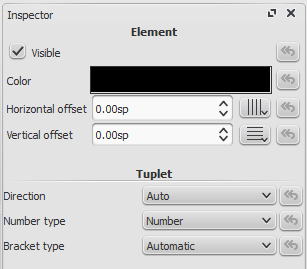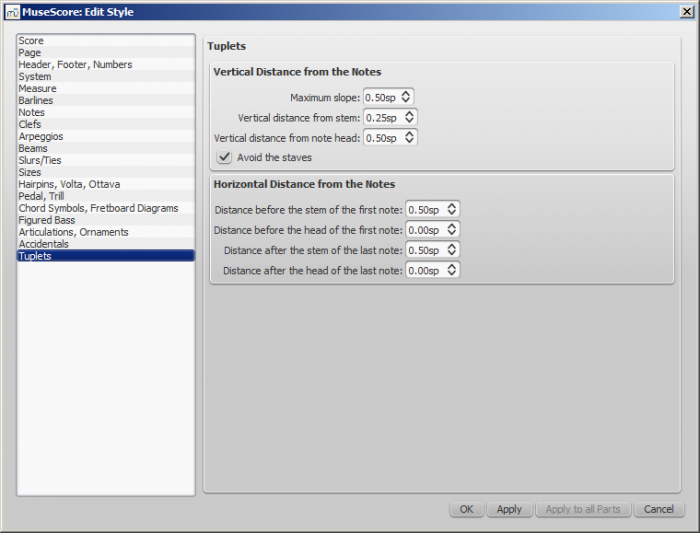Dấu liên
Tuplets are used to write rhythms beyond the beat divisions usually permitted by the time signature. For example, triplet eighth notes (quavers) in a 4-4 time signature divide the quarter note (crotchet) beat into three instead of two.
Instructions
To create a triplet, first select a note on the score that specifies the full duration of the triplet group. For example, a group of triplet eighth notes (quavers) has a "full duration" of one quarter note (crotchet).

From the main menu, choose Notes → Tuplets → Triplet. This creates a triplet by dividing the full duration into three equal parts.

They can be further edited.

Note input mode
Tuplet entry works slightly differently in note input mode than the method outlined above. You must select the duration first, and enter pitches afterward. Below are step-by-step instructions for making triplet eighth notes.
- Switch to note input mode by pressing N
- Make sure the note input marker is in the place that you want to start the tuplet (use the right and left arrow keys if necessary)
- Choose the duration for the whole tuplet group from the note input toolbar. For this example, click on the quarter note (or press 5 on the keyboard)
- From the main menu, choose Notes → Tuplets → Triplet, or press Ctrl+3 (Mac: ⌘+3)
- Notice that an eighth note duration is automatically selected. Click on the staff to add pitches or enter them via computer or MIDI keyboard
Properties
To change the display properties of a tuplet, select the tuplet number, or bracket, and use the Inspector (F8).

If neither the number nor the bracket is shown, select a note from the tuplet, then use the Tuplet button in Inspector to see the above dialog.

For Direction, choose Auto to place the bracket on the same side of the note heads as the stem, or beam. Choose Up, or Down to explicitly place the bracket above or below the note heads, respectively, regardless of the stem, or beam position.
For Number type, choose Number to show an integer, Relation to show a ratio of two integers, or Nothing to show no number at all.
For Bracket type, choose Automatic to hide the bracket for beamed notes and show the bracket if the tuplet includes unbeamed notes or rests. Choose Bracket, or Nothing to explicitly show, or hide the bracket, respectively.

If you move the bracket, or tuplet number, you can see vertical and horizontal offset being updated (default offsets are 0sp for both).
NOT FOUND: insepector2.png
You can restore default settings with the arrow return button on the right.
NOT FOUND: insepector_restoredafaultsettings.png
Style
Go to Style → General... and select Tuplets. It enables you to change all tuplet properties.

Two adjustments are possible: Vertical and Horizontal
- Vertical adjustment has three options with values in space units and one (un)ticked option
- Maximum slope: default value is 0.50; range is from 0.10 to 1.00
- Vertical distance from stem (see (2) below): default value is 0.25; range is from -5.00 to 5.00
- Vertical distance from note head (see (3) below): default value is 0.50; range is from -5.00 to 5.00
- Avoid the staves: by default ticked
- Horizontal has four options with values in space units
- Distance before the stem of the first note (see (5) below): default value is 0.50; range is from -5.00 to 5.00
- Distance before the head of the first note: default value is 0.00; range is from -5.00 to 5.00
- Distance after the stem of the last note (see (6) below): default value is 0.50; range is from -5.00 to 5.00
- Distance after the head of the last note: default value is 0.00; range is from -5.00 to 5.00

See also
External links
- Tuplet at Wikipedia
- How To Create Triplets in MuseScore [video]
- The User Guide to Tuplets in MuseScore [video]